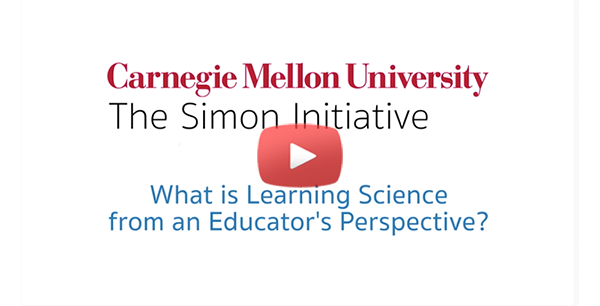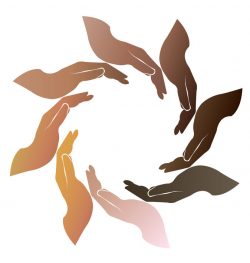Bringing TOPkit Digest to You
|
|
|
TOPkit empowers faculty development professionals with timely, trending resources and events. Our TOPkit Digest delivered monthly to your inbox offers practical tips to prepare faculty to teach online or blended courses. Because of your participation in the DT&L conference, you are invited to register to receive the TOPkit Digest.
|
|
|
The content in this month’s TOPkit Digest is brought to you by a collaboration between Melissa Jones, M.A., Instructional Systems and Learning Technologies, Florida State University (mkjones@fsu.edu) and Carla M. Nevarez, MBA, MSET, Assistant Instructional Designer, Center for Distributed Learning, University of Central Florida (carla.nevarez@ucf.edu) who discuss the topic of Learning Science.
|
|
Contents of this Digest:
- Video Tip: Learning Science from an Educator's Perspective
- Top Tips: Role of Learning Sciences in Instructional Design
- Must-Read Announcements: TOPkit Workshop, Hackathon
- From the Community: Engaging Conversations and Practical Advice
- Top Community Topics
|
|
What is Learning Science from an Educator's Perspective?
Helping Faculty Developers and Instructional Designers Understand the Study and Application of Learning Sciences |
|
|
MUST-READ ANNOUNCEMENTS - Save the Dates
- Join us for the live, virtual TOPkit Workshop 2022 , March 1-3.
- Plan to participate in our TOPkit Fall Hackathon 2021 with a kickoff on November 1st and sendoff on November 8th. Faculty development professionals will come together to individually or in groups improve upon or build a new artifact useful for their faculty development work. Colleagues plan, build, and briefly showcase their resulting efforts. More information to come.
|
|
The Role of Learning Sciences in Instructional Design
Applying Interdisciplinary Research to Design Practices |
|
|
|
In the early-2000s, scholars and practitioners from the fields of instructional systems design and learning sciences often engaged in academic debates about the intersections and the points of divergence between the two fields. These historical conversations can be observed in conference proceedings, academic publications, and even in a 2004 special issue of the journal Educational Technology. In this special issue, editors Alison Carr-Chellman, Ph.D. and Christopher Hoadley, Ph.D., open the edition with a simple title, “Learning Sciences and Instructional Systems: Beginning the Dialogue.” In the years since this seminal collection of articles, the two fields have indeed found there is great value in sharing this space of research, learning, and design.
For those who work in development and design, one of the greatest benefits from this confluence of fields is in the ability to apply the interdisciplinary work and research of learning scientists to the design process. Through the shared involvement with disciplines like computer science, neuroscience, and psychology, instructional designers and those who work in educational development are able to design learning environments and experiences that are both informed and supported by evidence.
|
|
|
|
|
|
|
|
|
#1 - Work at the Intersection of Learner-Centered and Knowledge-Centered Environments. Recognizing that all learners carry with them prior knowledge and previous experiences is a hallmark of a learner-centered environment, but evidence-informed practices also reiterate the importance of supporting learning through knowledge-centered environments. In course design, there are several practices that highlight the overlap of these two areas. Creating diagnostic opportunities, developing inclusive content, encouraging cognitive conflict, scaffolding support, and providing opportunities for reflection are all ways to honor the learners’ experiences while supporting their formal, discipline-specific growth.
|
|
#2 - Support Learning Transfer through Holistic Designs. One of the practices of learning scientists involves observing how the iterative process of learning occurs and transfers to a variety of authentic environments. For many educational endeavors, an indicator of success is often defined through the learners’ abilities to apply and transfer knowledge and skills to new situations. Understanding this form of transfer can help designers and developers construct more holistic learning experiences (Neelan & Kirschner, 2020, p. 35) through the creation of problem-based learning scenarios, social action projects, and authentic assessments. These holistic designs, with their focuses on unity, relationships, and connections, offer learners the opportunity to better experience both the course overall and the interconnectedness between the content and its applications.
|
|
#3 - Recognize the Learning Domains. In education, the focus of instructional design is often on the cognitive domain; however, with much of the work being done in the learning sciences, it is important to consider that there are multiple domains of learning, two of which include the affective and the psychomotor. With an awareness of the affective domain, designers may consider ways to create environments that support the learners as humans, recognizing the role their attitudes, motivations, and emotions play in their overall ability to learn. For the psychomotor domain, while there are limitations in the online environment, those who create e-Learning materials can engage learners through simulations and labs, interactive video demonstrations, and augmented and virtual realities. | |
#4 - Experiment with Learning Technologies. According to Sommerhoff et al. (2018), technology-enhanced learning is one of the main focuses of the learning sciences. The union of research and design and advances in technologies continue to offer more opportunities for learners to engage with the content and with each other in supportive, immersive, and adaptive ways. Through the adoption of various technologies, including those that utilize AI, game-based models, personalized branching, and multimedia-based learning objects and simulations, designers are able to create environments that have the “potential to modify our ways of thinking […] and the potential to change and enable learning processes” (p. 323).
|
|
Engaging Conversations and Practical Advice for Faculty Developers and Instructional Designers
Implications across Multiple Communities of Practice |
|
|
|
You may be interested in hearing more from leaders in the field of online education. Here are further-reading resources from some of these voices.
|
|
|
 | |
Join host Anthony Rotolo on The Learning Circle podcast as guest Clark Quinn, Ph.D., discusses his new book, Learning Science for Instructional Designers, a helpful guide for practitioners who wish to understand the science behind the methods we employ in modern learning.
|
|
|
Other Community Resources |
|
|
References and Works Consulted
Carr-Chellman, A. A. & Hoadley, C. M. (2004) Introduction to special issue: Learning sciences and instructional systems: Beginning the dialogue. Educational Technology, 44(3), 5-6. Cygiel, J. (Host). (2021, February 1). How learning science principles apply to ID and workplace learning with Tom McDowall (6) [Audio podcast episode]. In Learning Science Weekly. https://www.learningscienceweekly.com/student/activity/749597-episode-6-how-learning-science-principles-apply-to-id-and-workplace-learning-with-tom-mcdowall Cygiel, J. (Host). (2021, February 17). Taking an evidence-informed approach to training with Mirjam Neelen (9) [Audio podcast episode]. In Learning Science Weekly. https://www.learningscienceweekly.com/student/activity/763405-episode-9-taking-an-evidence-informed-approach-to-training-with-mirjam-neelen McDonald, J. K. (2021). The design of holistic learning environments. In J. K. McDonald & R. E. West (Eds.),Design for learning: Principles, processes, and praxis.EdTech Books. https://edtechbooks.org/id/the_design_of_holistic Muehl, J. (n.d.). Leveraging multimedia based learning objects to enhance online learning. TOPkit: Teaching Online Preparation Toolkit. https://topkit.org/developing/tools-techniques-strategies/leveraging-multimedia-based-learning-objects-to-enhance-online-learning/ National Research Council. (2000). How people learn: Brain, mind, experience, and school: Expanded edition. The National Academies Press. https://doi.org/10.17226/9853 Neelan, M., & Kirschner, P. A. (2020). Evidence-informed learning design. Kogan Page Limited. Northeastern Center for Advancing Teaching and Learning Through Research. (n.d.). Developing skills and promoting transfer skills. Teaching Strategies. https://learning.northeastern.edu/developing-skills/ Patson, N. D. (2020, May 2020). Getting students to discuss by channeling the affective domain. Faculty Focus. https://www.facultyfocus.com/articles/teaching-and-learning/getting-students-to-discuss-by-channeling-the-affective-domain/ Plass, J. L., Homer, B. D, & Kinzer, C. K. (2015). Foundations of game-based learning. Educational Psychologist, 50(4), 258-283. https://learning.northeastern.edu/developing-skills/ Quinn, C. N. (2021). Learning science for instructional designers: From cognition to design. ATD Press. https://www.facultyfocus.com/articles/teaching-and-learning/getting-students-to-discuss-by-channeling-the-affective-domain/ Rotolo, A. (Host). (2021, April 13). Clark Quinn on learning science for instructional designers [Audio podcast episode]. In The Learning Circle.
https://media.dau.edu/media/Clark+Quinn+on+Learning+Science+for+Instructional
+Designers/1_zw1nqr4f Sommerhoff, D., Szameitat, A., Vogel, F., Chernikova, O., Loderer, K., & Fischer, F. (2018). What do we teach when we teach the learning sciences? A document analysis of 75 graduate programs. Journal of the Learning Sciences, 27(2), 319–351. https://learning.northeastern.edu/developing-skills/ Sweller, J. (2006). The worked example effect and human cognition. Learning and Instruction, 16(2), 165-169. https://doi.org/10.1016/j.learninstruc.2006.02.005 Taylor, M. (2019, February 27). A look back at the year's best from learning science and instructional design. Mike Taylor. https://mike-taylor.org/2019/02/27/a-look-back-at-the-years-best-from-learning-science-and-instructional-design/#comments University at Buffalo Center for Educational Innovation. (n.d.) Domains of learning. https://www.buffalo.edu/ubcei/enhance/designing/learning-outcomes/domains-of-learning.html University of Central Florida Faculty Center for Teaching and Learning. (n.d.). Bloom’s taxonomy. https://fctl.ucf.edu/teaching-resources/course-design/blooms-taxonomy/ University of Waterloo Center for Teaching Excellence. (n.d.). Bloom’s taxonomy: Psychomotor domain.
https://uwaterloo.ca/centre-for-teaching-excellence/sites/ca.centre-for-teaching-excellence/files/uploads/files/psychomotor_domain_-_blooms_taxonomy_0.pdf
|
|
Developer and Editor
Bren Bedford, MNM, Web Project Analyst, Center for Distributed Learning, University of Central Florida
Editor
Samantha Richardson, B.A. English, Communications Specialist, Pegasus Innovation Lab, Center for Distributed Learning, University of Central Florida
|
|
|



